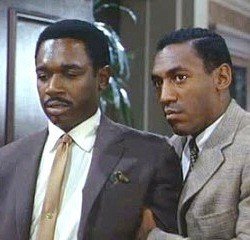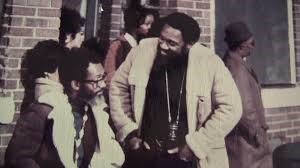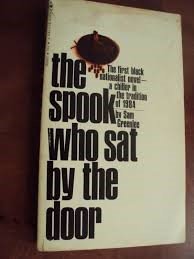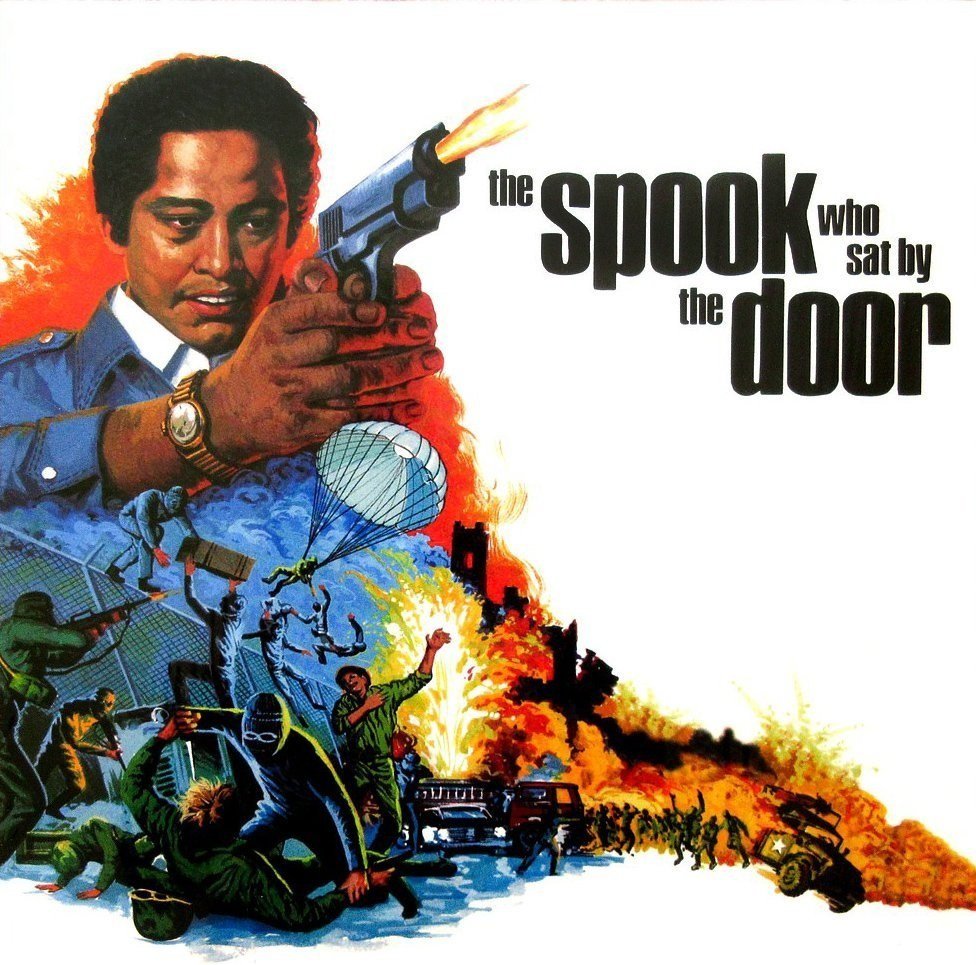IVAN DIXON: Hollywood’s Lonely Radical pt. 2: The Director As Revolutionary
Lawrence Cook as the first Black CIA agent Dan Freeman in The Spook Who Sat by the Door
"I saw ‘Trouble Man’ as an exercise; a way to learn how to direct movies, but it wasn’t anything serious. It was junk. It wasn’t until I read ‘Spook’ that I had found the material I was after."
- Ivan Dixon, 2009
With more conflict than I can reconcile (it is a subject for a theme of its own) I concede that it was Bill Cosby who gave Ivan Dixon his directorial debut opportunity. For a TV special. Cosby always recognized singular talent, no stranger to helping other Black artists. And while he became one of the biggest enablers of fine artists in the United States, he was also at one time the most visionary African-American producer of and investor in - politically and aesthetically radical art. He urged Richard Pryor to be himself and not copy his act, helping to unleash a latent genius. He helped Van Peebles with Sweetback, he gave him money to do it.
And he was aware of Ivan Dixon, that moody New York actor, who was coming into cultural prominence due to Hogan’s Heroes; for Cosby’s first TV show I Spy, he hired him for the role of an expatriate hiding out on the African continent who is being pursued by enemy agents. Cosby was supportive of both the counterculture and the mainstream. And by 1970, his image belied his radical interests.
Dixon and Cosby in the very first episode of I Spy, September 15, 1965
In 2006, well before the horrific facts about Cosby’s career as a serial rapist became known, Ivan Dixon, in an interview with Reelblack TV, gratefully acknowledged Cosby’s risk-taking on Dixon’s raw abilities as a director. Cosby had hired Dixon to direct a special on TV. He claims that Cosby never made him feel bad about what he felt was his own ineptness as a TV director. In the 1970s and 1980s, Cosby was simply the man everyone would have to be anointed by if they intended to get interesting projects done. A rapist inside a comedian inside a cultural bearer inside a Black entrepreneur. One wonders what film Dixon and Greenlee would create had they worked on a joint film inspired by Cosby’s crimes.
*
If Duff, the main character in Michael Roemer’s 1963 drama Nothing But a Man, was the greatest acting Ivan Dixon ever did, The Spook Who Sat by the Door would be his most significant work as director and possibly his most personal. The ten-year span between those two impactful moments in Dixon’s life enveloped a lot of changes and a lot of expanded consciousness.
While Black theater was a phenomenal parallel to the political movements of the 1960s and the incredible militancy that transpired after Malcolm X’s murder, this radicalism - although it permeated pop music in a clever and safe way - had a difficult time finding its feet in American movies, especially Black films.
The American underground and independent cinema only had a few notables who took up the Left-Wing revolutionary mantle like Robert Kramer, Haile Gerima, Larry Clark (not to be confused with the nihilistic white director of Kids) and establishment Hollywood radicals such as the blacklisted Jules Dassin (his collaboration with Ruby Dee in 1968’s “Uptight!” is excellent) and rousing mavericks like Melvin Van Peebles, who did not necessarily subscribe to a political ideology, he simply was vehemently against racism and how America perceived itself and in 1970 that alone was enough to brand anyone a radical.
Following an incredible run of revolutionary movies that will never be surpassed in mainstream cinema (Van Peebles’ Story of a Three Day Pass, Watermelon Man, and his watershed Sweet Sweetback’s Baadassss Song), Dixon’s literal cinematic revolt - the sublime rendering of Sam Greenlee’s The Spook Who Sat by the Door, came out in 1973. It appeared in theaters alongside Hollywood depictions of a rotting system - The Hospital with George C. Scott (in a riveting script by Paddy Chayefsky) and Sidney Lumet’s Serpico with Al Pacino, and it blew the roof off in more ways than one. The fact that these three films alone existed in mainstream channels some thirty years before Americans could even accept their messages is astounding. The Spook Who Sat by the Door was - and remains - not only a primer of Black revolution and American radical cinema itself but a signal that there was indeed a new culture beyond the conception of what a “movie” could be and proof that Black filmmakers could explore liberation ideologies in more ways than one.
Spook shares similarities with, and is an ally of, Sweetback as well as Christopher St. John’s Top of the Heap. And while all three relay a ferocious point of view regarding the existential crisis of Black Americans and readily avail themselves to revolution in all senses of the word, Spook is the film that literally exists in the DuBoisian double-consciousness sense because it is both entertainment AND art and within that - a revolutionary manifesto. This had never been done in either an art film or product intended for the mainstream disenfranchised Blacks, helmed by two increasingly outlaw Black artists not to be dismissed in director Ivan Dixon and author Sam Greenlee.
Marvin Gaye provided a superb soundtrack to what was a cool, almost fun, action movie starring Robert Hooks. Dixon disowned the movie, but he learned a lot about lenses and editing while making it.
Dixon’s feature film directorial debut for Twentieth Century Fox, Trouble Man - featuring a haunting soundtrack by Marvin Gaye (no, Dixon and Gaye never met in person, unfortunately) - starred Robert Hooks and came amidst Hollywood's rise of exploitation pictures in 1972. Dixon saw it as just another action genre film, but one he could at least do “in my own way” (no nudity, for example, which was all the rage in 1972). Although quite a decent movie, save for the preposterous ultra-violent ending, he dismissed it as he dismissed much of his Hollywood career. It was just a paycheck to him (as was his disenchanting involvement but wonderful payday with Hogan’s Heroes).
THE REVOLUTION WILL BE FILMED
Dixon had always been unimpressed with most facets of Hollywood filmmaking and found he was more akin to Third Cinema - the Third World’s call for a decolonized cinema - and the idea of film as an artistic political weapon. He was deeply impressed by Senegalese cinema, and the power of Djibirl Diop Mambety who had just made Touki Bouki.
With The Spook Who Sat by the Door Dixon could pick up where he left off with the remarkable creative caliber of Duff and channel into the militancy of Lonnie, the role he played in Car Wash. This time as a director. All roads in some way led to his, and screenwriter Sam Greenlee’s, greatest achievement.
Freeman (Lawrence Cook) the “spook” revolutionary and Dawson (J.A. Preston), the middle-class policeman. Like gangster movies or Elizabethan tragedy, Spook hinges upon the imminent betrayal of one brother against another. While Al Pacino slayed John Cazale in The Godfather Part II, the angst is turned inward when it concerns revolution. The scenes between Cook and Dawson are amongst the finest in screen acting. At times Dixon frames them literally: with the revolutionary on the LEFT of the frame and the oppressive state on the RIGHT.
“‘Spook’ is highly unusual for an American film in that its radical left-wing politics are so overt and explicit.
”
Indeed, the film projects a revolutionary vision in an almost classical way: it insists that the vanguard will come from the ghettos, the unemployed, the impoverished. The peasants, not the proletariat, not the workers, but the “un-working,” marginalized unemployed. All the things that are not sexy or hard to glamorize. And when Western cinema does, it is always through the veneer of Jay-Z and “ghetto fabulous” drug dealer tropes. The establishment cannot conceive of or handle Black peasants who want revolution, not bling. Blacks who deal in radical hope, not reactionary dope.
About the first Black CIA agent (granting “Spook” with a double-entendre) who, while playing the role of a meaningless reprographics lackey for the CIA in an office by the door, covertly creates and trains a group of Black guerrilla soldiers in Chicago’s South side to revolt against the United States government, Greenlee’s novel was rejected multiple times by various publishers that he knew most likely no one would ever touch it. Highly intelligent and politically robust, Greenlee came to write the novel after his experiences in the military overseas in the Middle East and involvement in the Foreign Service. Having witnessed the Algerian revolution, Greenlee realized that the “South side of Chicago was a third world country.” He could relate to all oppressed groups and revolutions against colonial imperialists and racist regimes.
Written in 1965 amidst the Watts uprising, (ironically as Fanon’s Wretched of the Earth was just exploding) the novel was finally published in 1969 by a British publisher, thanks to Alexis Lykiard whom Greenlee bonded over a love of jazz while they both lived in Mykonos, a Greek Island. Having met Melvin Clay, who was a member of the radical theater group The Living Theater, Greenlee wrote the screenplay adaptation of Spook in six weeks. The result was a resounding 200 pages. The goal, like the novel itself, was to create a handbook for revolution – this time for the screen and directly for the Black proletariat, those who lived, breathed, ached, died and laughed in the ghettos. Those who knew if their middle-class brethren had turned their backs, they would be eternally forsaken and completely on their own. Not unlike the Russian peasants, just a little over a hundred years earlier.
“What we’ve got now is a colony. But what we want to create is a new nation.”
“Spook is my own fantasy about how I felt about racism, this country, the frustrations of being in a white industry and controlled by that,” Dixon has declared. The movie enabled him to say “look at the film to see how I feel about racism.”
Greenlee, who had no artistic ambitions with his novel – his zeal was purely political; he wanted a didactic film to engage and agitate - was harmoniously conjoined with Dixon. Together, the way Martin Scorsese would later find himself in Paul Schrader or how Richard Pryor found a partner in Paul Mooney, this radical dynamic duo were ready to create a film that would finally express the turmoil, frustration, anger, and anxiety they felt about America, race relations, the poor, and the imminent revolution that they felt others were either denying or not taking seriously. The failure of the Leftist and Black militant revolution of the sixties left a hole in the vision and outlook of the revolutionary-minded artists and activists by 1970. Once the Black bourgeoisie turned their back and COINTELPRO (the FBI’s covert and illegal terrorizing of Civil Rights activists and radical groups, namely the Black Panther Party) reared its head, the new obstacle was drugs. Not human rights or fighting capitalism. In the aftermath of the 60s, the pressure was to party, not organize.
“When they (United Artists, distributor) saw the final cut, a deathly silence descended over the room…Most of the Blacks in the film industry tap-dance and do anything to get into a movie or make a movie. Along comes this radical little dude like me who doesn’t give a damn about Hollywood or white folks. They did not know who they were dealing with.”
- Sam Greenlee, Author & Screenwriter
Produced with money from Black organizations and individual Black working-class supporters (Dixon always professed his gratitude and camaraderie with the workers, he had maintained that the Black bourgeoisie never supported him and that poor Blacks were always more willing to give him money for Spook) and post-production funds from United Artists, both Dixon and Greenlee went into Spook slightly naive, but they came out wiser and stronger.
Greenlee himself who owned the rights to the film until the day he died in 2014, surviving on food stamps, but proudly dignified in his stands as an artist and man of the people, always claimed that Dixon couldn’t see the trap laid out for them with such a film. The film’s alliance with global victims of colonization and torture was enough to make the United States government fear the potential impact the film would have. Gillo Pontecorvo’s The Battle of Algiers galvanized revolutionaries all over the world (The Black Panther Party, Irish Republican Army, etc) - so with an internal American made movie about Blacks committed to an uprising easily set the government on its toes. The fact that few critics - or Marxist filmmakers - rarely compare Algiers with Spook is astounding. The ignorance is overwhelming. In a 2011 Criterion article on Battle of Algiers, Spook is not even a footnote; not one single Black American radical film is mentioned. While there is a dearth of them, the few that exist are all unique and powerful, and some are even masterpieces.
The tragedy of The Spook Who Sat by the Door’s trajectory has been well documented. Indiana University Press’ Race and The Revolutionary Impulse in the Spook Who Sat by the Door by Michael T. Martin, David C. Wall and Marilyn Yaquinto is an achievement. An illuminating menagerie of interviews and essays about the film, it is a must-have for cinephiles, radical Black filmmaking, and anyone seeking further information about the film and the circumstances surrounding its conception (Greenlee’s casual remark about how different he is from Spike Lee is priceless!)
Despite United Artists’ resentment of the film, they begrudgingly honored their distribution agreement with a 21-city tour of the film. However, several reports throughout the country echoed the same refrain: the film opened on Friday, but closed on Sunday. Despite the fact that it did extremely well at the box office in Chicago when it first kicked off.
Christine Achem’s documentary The Rise and Fall of the Spook Who Sat by the Door (2011), informs us that movie theaters in Chicago alone were threatened by the FBI and all ‘requests' to stop showing the film were duly understood. “A contingent of the FBI sat down with the executives of United Artists and they agreed to take the film off the market,” Sam Greenlee later insisted.
In fact, had Dixon and Greenlee not had the foresight to hide a copy of the film in storage under a false name — anyone born in the sixties onward might have never seen the film.
There are few commercial films that the United States government ever got nervous about and for different reasons: Frank Capra’s Mr. Smith Goes to Washington (1939), Herbert Biberman’s Salt of the Earth (1954), Margaret Sanger’s Birth Control (1917), Howard Hawks’ Scarface with Paul Muni (1932)...but none suffered the fate, of course, as Spook did. Even more interesting is the fact that it is now considered an American treasure: it is in the Library of Congress’ National Film Registry. And of course, Dixon and Greenlee are dead.
Over the course of the film, Cook’s expression grows more and more dour; his suspicious eyes never betray the frustration and disappointment he perceives in the Blacks who choose to be part of the system.
The Spook Who Sat by the Door opens like a black comedy. It almost feels like Douglas Turner Ward had written the opening. We see a US senator, his wife, and his Black aide - gravely strategizing how to retrieve the senator’s “lost Black vote.” His conservative bent has alienated any Black voters he may have had, then his wife gets an idea about accusing the CIA for not having any Blacks and they quickly concoct a marketing idea to hurriedly find and make a Black CIA “the best known spy since 007.” This is all with a straight face. Hilarious. And it’s executed wonderfully. What corporate America and Hollywood is doing now in practice is what the opening scene satirizes. And with that, the film is off, getting darker and insightful with every succeeding scene.
Jittery music by Herbie Hancock enables the tension of the film. The taut visual compositions of the cinematography in tandem with handheld work gives the film another layer of unease. But really it’s the finesse in which Lawrence Cook as Freeman recruits Blacks from the ghetto into a revolutionary vanguard party that really impresses and defines the tenor of the film. Its seriousness is not without humor or levity but it is apparent right before their first action - a bank heist ( For they need start-up money for their revolution don’t they?) - that sadness also underlies the anger and justifiable outrage towards the white racist capitalist empire that chokes them. The beautiful moment when Willie, who is so light he could pass for white, warns Freeman that no matter what he may look like he is convinced that a racist white man is “probably gonna put a bullet in the back of my head.” He doesn’t realize that Freeman wants to use Willie and the “yellow” Blacks to pull the bank heist because the cops will be looking for white men because there is no way in hell they’d believe Black criminals could pull such a thing off.
Sam Greenlee was a powerful writer of dialogue and character and he should have been able to have developed into a better-known or greater dramatist than at least half his contemporaries. Dixon’s mild-mannered directing, his droll matter-of-fact pacing, his exquisite detail to the literal actions compounded with Freeman’s arc is what initially grants the film revolutionary status formally.
If art is to be revolutionary, it must be revolutionary in form Bertolt Brecht insisted in the twentieth century. I would add that only a revolutionary film can be made by a revolutionary artist. In film, it is a point of contention and great anxiety. The Soviet revolutionary director Sergei Eisenstein, maintained that cinema should be its own language and not even reference the other arts.
Further revolutionary inclinations in cinema range from honoring the underdog’s point-of-view (which Spook does seamlessly), working against action and mobility on screen (single shots held for longer duration, dialogue-driven scenes coinciding with detailed action scenes) moments of pure subversive illustration (as when we see Freeman actually exhibit examples of guerrilla warfare), astute class analysis (the film is critical of the Black bourgeoisie), conscientious reflections of one’s own involvement or existence in society.
Dixon directed Spook with extraordinary aplomb and severe apollonian grace missing from most movies. Its calculating, intellectual pace is rare for a “genre film,” and Lawrence Cook’s understated cool may rival Dixon’s own screen persona. Paula Kelly - the Black radical film’s Jean Seberg - makes another charismatic, offbeat and dignified performance as a ‘Lady of the Night’ who goes from turning tricks to be a revolutionary spy for Freeman. AJ Preston, Janet League, David Lemieux, Paul Butler, Don Blakely - all give superb performances. But the entire ensemble is excellent. The dialogue is intelligent, evocative, provocative…and all couched in a tense naturalism.
The father of the American revolutionary dramatic movie (the grandfather might be Robert Kramer’s Ice) its influence, though spare and lean on succeeding American filmmakers (Robert Townsend is a huge admirer) of the Left, Black or white, is mostly felt spiritually within the Black community as a vital example of Black political consciousness, on par with any of the sermons Public Enemy or Richard Pryor had to offer us. But this is less about content and subject and more about the talent and skill and techniques employed. The how is what ends up endowing a revolutionary work of art with that certain “something” that its commercial or well-intentioned “socially conscious” movie doesn’t possess. And having this certain something - this magical blend of political ideology and talent to express it creatively - endows the film with a success that only a real work of folk art can attain.
Hollywood is no stranger to the demoralization of revolutionary fervor and liberation politics. Wasn’t it James Baldwin who famously admonished himself for conferring with Hollywood producers about a movie in what would amount to, in his own words, as “the second assassination of Malcolm X”?
Spook was, and is, the real deal. It would be nice if “radical filmmakers” (are there any left?) could get the acknowledgment they deserve in a broader context, but also if the current generation of establishment directors would honor the techniques and soul inherent in such films as Spook, Top of the Heap, Ice…and investigate what made those films revolutionary to begin with. It’s simple: a revolutionary film is, at the end of the day, when a revolutionary - who happens to be an artist - makes it.
The first step in any revolution is taking over the news outlets. In this case, the old style DJ radio studio. Freeman iterates throughout the film that the uprising is not about hating (white people) but in loving and longing for freedom for everyone.
Dixon may have had a greater impact on Generation X’s underground (Dionysus 2000 Theater Lab, John Brown X Productions, filmmaker Vagabond’s Audio Visual Terrrorism, etc) than he did on the current crop of Hollywood’s “woke'' stable, but one thing is clear: his legacy is rooted firmly in the hearts and minds of other artists. Being an “actor’s actor” for example is not pejorative. It is a rare privilege.
With that said, The Spook Who Sat By The Door may exceed the political desires or aesthetic inclinations of our new wave directors, but according to the 58th annual New York Film Festival back in September 2020 – it packed a well-received punch for audiences as it was selected for the festival by filmmaker Ephraim Asili 47 years after it was made. More startling, if not depressing, is the fact that reactionary provocateur Lee Daniels now owns the production rights to the Spook Who Sat by the Door. All I will say is that it’s a good thing death exists: could you imagine the horror they’d feel if Greenlee and Dixon were alive to witness this?
A Rare Moment: Greenlee (left) and Dixon (right) on the set of "Spook...", Chicago, 1973
CODA
“In one respect maybe we were like spooks who sat by the door but they (Poitier, Belafonte, etc) were different kinds of spooks than me…Poitier made adjustments to what the white controllers of the industry were trying to do to him (by) making slight adjustments to his character that he knew that Black audiences would appreciate, which he did well. But I just wanted to blast them.”
Ivan Dixon was a radical who did not write manifestos or engage in organized activism to express his feelings and ideas. He acted and directed revolutions, insofar as that is even possible. He was an artist with a penchant for rebellion emotionally and intellectually. His acting and directing, while not prolific, was acute and conscientious.
In the end, the final ingredient of a revolutionary film? The author must desire to risk anything in order to express everything.
So is it the same old story? The subversive work of art that becomes suppressed by the powers that be?
And this is where the lesson must be learned - for those who dare to utilize cinema as a revolutionary tool, as an expression of outrage, love, and tool for liberation, one must understand the consequences of being bold, Black, and speaking truth.
One of Dixon’s last public statements was to encourage the present generation, and always the youth, to pay attention to the world we are living in, “the world is a mess.” Two years before Bernie Madoff and Barack Obama commandeered the culture, he gently admitted that he worried “about us.” Meaning, Black Americans.
Having renounced the film world - professionally and artistically - he made a successful turn as a radio host and owner of a station in Hawaii for some years but he never ever regretted his two beloved contributions, Nothing But a Man and The Spook Who Sat by the Door. A militant minimalist, his two glorious shining examples of acting and directing in narrative cinema are extreme seminars on body language, consciousness, dignity, self-expression, love and revolution.
We need more gentlemen actors. And we need them to make more revolutionary films.
We love you, Ivan Dixon.
*










